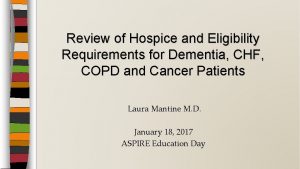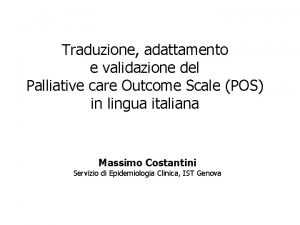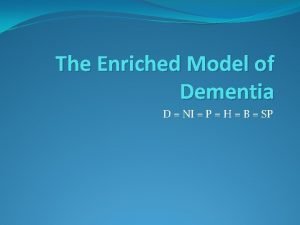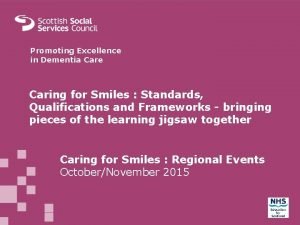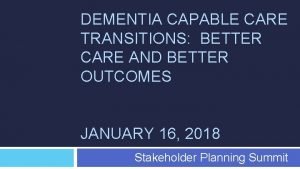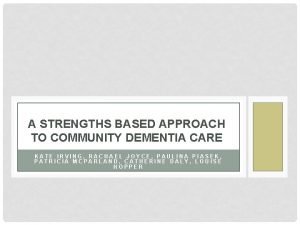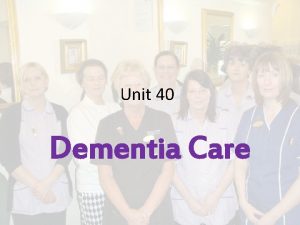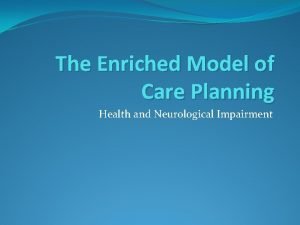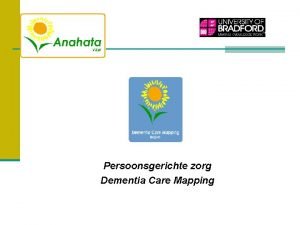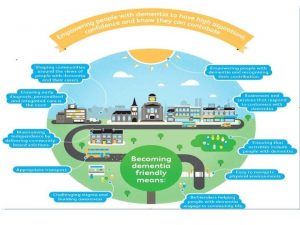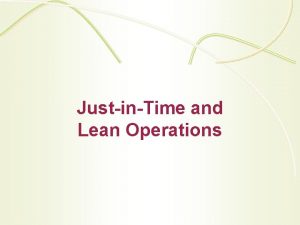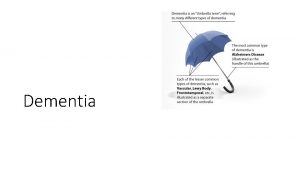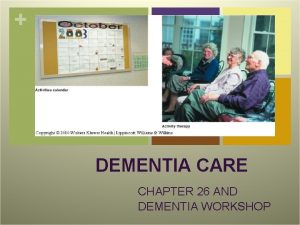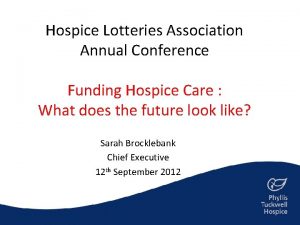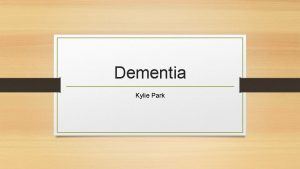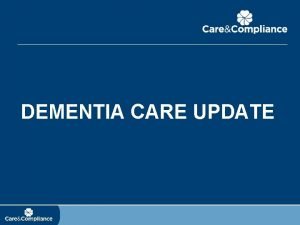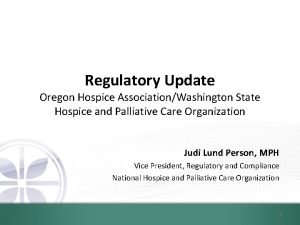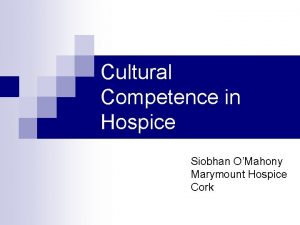Hospice Approach to Dementia Care Partnerships to Improve




















- Slides: 20

Hospice Approach to Dementia Care Partnerships to Improve Care and Quality of Life for Persons with Dementia

Training Goals for series v Enhance family involvement in the daily care of loved ones with dementia v Promote person-centered care Goals for today v Describe the importance of palliative care in dementia care v Promote advanced planning to reduce stress/crisisbased decisions

Dementia: A Terminal Disease Stages of dementia: Early, Middle, Late v Late stage Terminal dementia ü Very severe dementia ü Advanced dementia v Loss of abilities results in related health risks ü Infections, fevers ü Weight loss, dehydration ü Other complications v Other health problems progress

Dementia Progression + Goals of Care

Advanced Dementia Global Deterioration Scale: Very Severe Decline No Very Mild EARLY v v Mild Mod Severe MIDDLE Profound memory loss: doesn’t recognize family members Loss of speech Inability to ambulate/walk Inability to perform activities of daily living ü Bathing, grooming, dressing, toileting, transferring, eating v Incontinence: urinary and fecal LATE Very Severe

Comfort Care Palliative Care v v v Improve quality of life Alleviate pain Address uncomfortable symptoms, problems Appropriate throughout an illness Comfort is the primary concern Goals of care direct decision-making

Preventing, Relieving Pain Indirect consequence of progressive disability v Physical pain/discomfort ü Comorbid conditions: Osteoarthritis, diabetic neuropathy, degenerative joint disease, others ü Immobility: Pain on movement due to muscle stiffness, soreness, contractures ü Procedural: Pain resulting from care and treatments v Emotional/psychological discomfort ü Distress, discomfort, confusion related to environment ü Resistance to care/behavior symptoms

Advance Care Planning Prepare person/family about what to expect in advanced stage v Start early v Talk about what is to come v Identify treatment preferences before complications occur v Establish directives in writing v Structured guides/materials help ü Hospice approach: Dementia specific discussion ü Physician Order of Life-Sustaining Treatment (POLST)

Family Goals for Dementia Care Medical care and end of life in advanced dementia v Doesn’t get burdensome medical care v Stays out of the hospital v Doesn’t take medications with side-effects Quality of life v Lives in preferred setting v Able to socialized with family/friends Values and Knowledge both guide decisions!

Reducing Burdensome Care Evidence has been building since the 1980 s! In late stage… v CPR is rarely successful in frail elderly v Hospitalization is often traumatic due to confusion v Infection treatment may not improve outcomes v Feeding tubes cause more problems than do good ü Acute confusion/delirium ü Discomfort

Burdensome Care: CPR Cardiopulmonary resuscitation (CPR) v Broken ribs/pain v Greater confusion, delirium v Greater cognitive impairment than before arrest v Traumatic to family members

Hospitalization Transfer to Emergency Department or Hospital v Experience is confusing, distressing, anxiety/fear provoking v Functional abilities decline as a result v 75% are avoidable ü Unnecessary: Pneumonia treated as effectively in nursing home as hospital ü Contrary to person’s preferences v Acute care decision-making vs. goals of care

Infections Leading cause of hospitalization: Infections & fevers v Pneumonia: aspiration and community acquired v Urinary tract (UTI): immobility, dehydration, incontinence v Antibiotic treatment in terminal dementia ü Survival, symptom relief not clearly superior to comfort measures ü Risk adverse effects: GI upset, diarrhea ü Discomfort with diagnostics: blood draw, X-ray, sputum sample, urine sample by catheterization

Eating Problems Hallmark of Advanced Dementia: Eating/swallowing problems v Pocketing, spitting food; delayed swallowing, aspiration v Inability to feed self; loss of interest in food v Feeding tubes: still common but not helpful ü Discomfort, delirium increased ü Survival rates not improved over hand feeding v Preferred approach: self or hand feeding ü Smaller portions, finger foods, favorite foods, nutritional supplements ü High calorie/high nutrition/low volume diet

Avoid Reactive Care Better to anticipate problems than REACT! v Goal-directed care Anticipate losses and plan for them! v Advanced care planning Talk about issues ahead of time v Avoid “crisis-mode” decision making ü Pneumonia results in hospitalization ü Stopping eating leads to feeding tubes ü Infections lead to antibiotics v But what about the COMFORT of the person in late stage dementia?

Hospice Approach to Dementia Care v First PALLIATIVE CARE model for advanced dementia v Goal: Finding a balance as dementia progresses ü Prolonging life vs. preventing suffering ü Focus on promoting comfort & quality of life v Approach: Family discussions about care ü Person’s values & beliefs ü Intervention options/choices ü Risks and benefits to person ü Reviewed at each care planning meeting

Hospice Approach: 5 levels Level 1 Level 2 Level 3 Level 4 Level 5 Aggressive diagnostic workup Treat coexisting medical conditions Transfer to acute care Infection treatment: UTI, pneumonia CPR Feeding tube Antipyretics (fever), analgesic (pain) Hand feeding, drinking as able

Palliative Care and Hospice Care The Hospice Approach blends palliative care with hospice v Both target treating pain and discomfort ü Quality of life, not length of life ü Comfort is the primary aim v Palliative care: not time limited ü Doesn’t exclude treatments that may prolong life v Hospice: life expectancy of 6 months or less ü Only comfort measures are provided

Summary v v v v Goals of care for terminal dementia are best addressed early Knowledge and values are both important No one right solution for all persons/families! Comfort is often primary Apply principles of advance care planning Use the Hospice Approach to guide treatment options Avoid reactive decisions Promote quality of life for the person with dementia!

Last module in our series! Thanks for your time and interest!!!
 Fast score hospice
Fast score hospice Palliative care versus hospice care
Palliative care versus hospice care Hospice of the bluegrass frankfort ky
Hospice of the bluegrass frankfort ky Franciscan palliative care
Franciscan palliative care Traduttore italiano inglese
Traduttore italiano inglese Enriched model of dementia care
Enriched model of dementia care Tom kitwood enriched model of dementia care
Tom kitwood enriched model of dementia care Promoting excellence in dementia care
Promoting excellence in dementia care Dementia capable care
Dementia capable care Strength based dementia care
Strength based dementia care Unit 40 dementia care
Unit 40 dementia care Enriched model of dementia care
Enriched model of dementia care Dcm methode
Dcm methode Dementia care in bath
Dementia care in bath Primary, secondary, tertiary care
Primary, secondary, tertiary care Accounting for partnerships chapter 12 solutions
Accounting for partnerships chapter 12 solutions Accenture development partnerships
Accenture development partnerships Complete the word partnerships with brand product or market
Complete the word partnerships with brand product or market Product development partnerships
Product development partnerships Characteristics of just-in-time partnerships do not include
Characteristics of just-in-time partnerships do not include Maintaining effective partnerships
Maintaining effective partnerships
